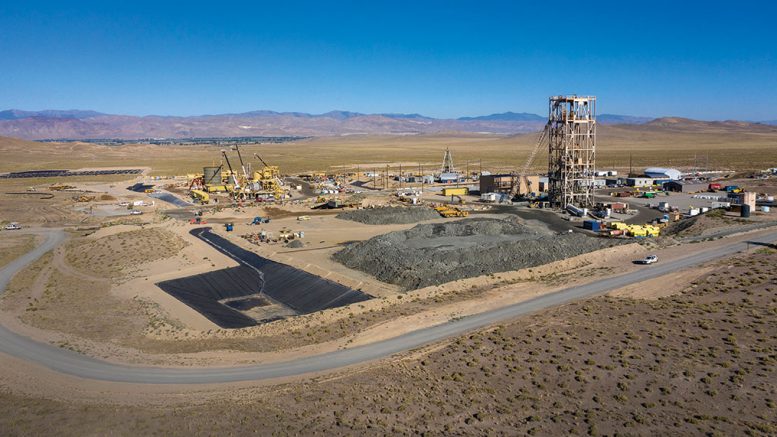Under the cloud of slumping base metal prices, advanced-stage developer Nevada Copper (TSX: NCU) says it remains on schedule at its ongoing build of the wholly owned Pumpkin Hollow copper mine project, located near Yerington in west-central Nevada. The planned 4,500-tonne-per-day underground copper mine is slated for start-up by year-end, with a proposed second-stage, open-pit phase aiming to come online in 2023. The development project is touted by the company as one of two major North American copper projects currently in construction.
Based on its latest prefeasibility study, the underground mine is expected to produce 50 million lb. copper, 8,000 oz. gold and 150,000 oz. silver annually over its modelled 13.5-year mine life. Annual output over its first five years is modelled slightly higher at 60 million lb. copper, 9,000 oz. gold and 173,000 oz. silver. Proven and probable reserves (for the underground mining stage) are pegged at 21.7 million tonnes grading 1.59% copper, with minor gold-and-silver credits. Pre-production capex for the underground mine comes in at US$197 million.
The company’s latest Pumpkin Hollow construction update shows progress on both underground development and surface infrastructure, and reaffirms its start-up schedule for this year’s fourth quarter.

David Swisher, vice-president of operations, holds a map at Nevada Copper’s Pumpkin Hollow copper project in Nevada. Photo by Frik Els.
Once its underground operation is online, the next task is the fully permitted, second-stage, open-pit plan that models an average output of 163 million lb. copper production annually over 19 years of operational life, with proven and probable reserves of 350 million tonnes grading 0.47% copper, plus minor gold-and-silver credits. The company proposes a phased open-pit mine plan starting at 34,000 tonnes per day in 2023 — with an estimated initial capital build cost of US$672 million — followed by a potential expansion to 64,000 tonnes per day, with another US$473 million in estimated capital costs.
The company announced its final full underground construction decision a year ago, after a $108.5-million equity raise to top up the treasury. Another $40 million was raised this year through an equity financing, plus a US$115-million project finance facility put in place through German international project and export financing bank KfW IPEX-Bank to get Nevada Copper across the finish line to producer.
The catalyst to Nevada Copper’s path to production came through a major business recapitalization announced in late 2017 (featuring a US$378-million construction financing package) that resurrected its past development plans, and included a new management team and board of directors. Components of the deal included a US$70-million precious metals stream, an US$80-million, senior-secured loan, and US$53 million in debt to equity conversion by Red Kite Mine Finance and Pala Investments, plus a working capital facility and equity commitments.
Nevada Copper first acquired the Pumpkin Hollow property in 2006, and has undertaken close to 200,000 metres of drilling since then to build and upgrade the copper project’s resource base. Multiple preliminary economic development and feasibility studies reviewed various integrations of open-pit and underground development options, and the company started building a production shaft, but ran short of capital to finish the development in 2015, after cumulative capital spending of over US$200 million.
Copper price sensitivity
Along with most global copper operations, Pumpkin Hollow has sensitivity to current weak spot copper prices, plus dropping consensus forecasts. Under Nevada Copper’s consensus-case scenario — with copper prices of US$2.83 per lb. in 2019, US$3.05 per lb. in 2020, US$3.14 per lb. in 2021 and US$3.20 per lb. from 2022 on — the company models underground operations having a US$301-million, after-tax net present value (NPV) at a 5% discount rate, 25.2% after-tax internal rate of return (IRR) and 4.75-year payback. However, under its low-case scenario (a copper price of US$2.60 per lb., which is where the market sits at press time) the after-tax NPV (5%) slips to US$100 million, after-tax IRR drops to 12.8% and payback increases to 6.5 years.

A crew installing a power line at the Pumpkin Hollow copper project. Credit: Nevada Copper.
Copper prices have dipped to a more than two-year low, down to the US$2.56 per lb. (US$5,650-per-tonne) level, bearing the wrath of renewed and escalating U.S. and China trade war fears. In mid-August, the U.S. threatened to impose 10% tariffs starting Sept. 1 on the other US$300 billion in Chinese imports not already taxed, after 25% tariffs previously applied to US$250 billion of Chinese products. The move triggered drops in stock market indexes, and commodities (such as the base metal complex) saw price declines, fearing lower industrial growth and consumption levels in China, the world’s largest copper consumer.Consensus forecast copper prices amongst commodity analysts has swung bearish over the past few months, with the latest 2019 forecasts slipping to US$2.80 per lb., down 5% from a couple months before. A similar drop is modelled by analysts for the red metal’s 2020 forecast price, which is pegged at US$2.92 per pound.
The latest report out of the International Copper Study Group outlines a 150,000-tonne deficit in the world-refined copper balance for the first four months of 2019. However, the study also indicates growing copper stocks held at the major metal exchanges (i.e. London Metal Exchange, COMEX [CME Group] and Shanghai Futures Exchange) as of mid-year 2019 totalling 417,660 tonnes — a 67,164-tonne increase (up 19%) from reported stocks at the end of 2018. Reported exchange copper inventories rose to the 479,000-tonne level at the end of July.
Shares of Nevada Copper traded at 29.5¢ at press time, a 52-week low, giving the soon-to-be producer a $225-million market capitalization, based on the company’s 662 million shares outstanding. (The company hit a 52-week high of 55¢ in September 2018.)
— Steve Stakiw is a geologist and former Western editor for The Northern Miner. Most recently, he has spent over 10 years in a senior role with a zinc-focused, base metals producer with operations on three continents.


Be the first to comment on "Nevada Copper closing in on Pumpkin Hollow production"